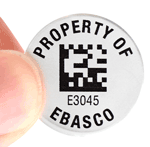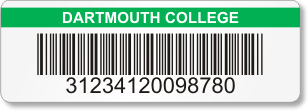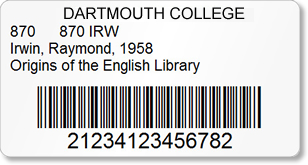Barcode Location:
It is important to pick the location of barcode labels
on library materials carefully, because there are various drawbacks and benefits
to different locations. Library barcodes, when purchased for an entire collection,
can be expensive, so many libraries only purchase one label per item.
If you only plan to place one barcode on each item, then there are two main factors
to consider: the longevity of the barcode, and the convenience it offers.
Placing the barcode on the inside back cover of a book offers good protection.
Affixed to the inside of the book, the barcode will encounter less wear-and-tear
and will be less likely to get picked off. As a result, your barcodes will last longer,
and over time, fewer barcodes will have to be replaced.
Furthermore, if you plan to use book pockets or due-date slips,
barcodes placed inside books will increase the efficiency of your check-out system.
If you do not plan to use due-date slips or book pockets, however,
placing your barcodes inside the back covers of books may not be the
most efficient system. Placing the barcode on the outside cover allows
you to take inventory and perform in-house scanning without opening the booking or,
if the label is placed on the spine, without removing it from the shelf.














 be applied at random to the items in your collection. Dumb barcodes are barcodes that have not been linked to specific item records in your database. As a result, once they have been applied, your library
staff will have to link the barcode on each book to the appropriate entry in your database. This will entail locating each books item record in the database, and either manually typing in the barcode number or using a scanner to scan it in.
be applied at random to the items in your collection. Dumb barcodes are barcodes that have not been linked to specific item records in your database. As a result, once they have been applied, your library
staff will have to link the barcode on each book to the appropriate entry in your database. This will entail locating each books item record in the database, and either manually typing in the barcode number or using a scanner to scan it in.

 records before it is printed. This is useful because it avoids the tedious work of linking each books and barcode to the correct item record in the database. Smart barcodes are usually produced by sending a full list of
books and other inventory items to a vendor who then generates barcodes for each item and prints them out. For libraries with a comprehensive call-number system it is easy to apply
smart barcodes, because they are usually printed according to shelf order. Since shelf arrangement is critical to the process, a preliminary self reading campaign should be considered to make
sure everything is in order.
records before it is printed. This is useful because it avoids the tedious work of linking each books and barcode to the correct item record in the database. Smart barcodes are usually produced by sending a full list of
books and other inventory items to a vendor who then generates barcodes for each item and prints them out. For libraries with a comprehensive call-number system it is easy to apply
smart barcodes, because they are usually printed according to shelf order. Since shelf arrangement is critical to the process, a preliminary self reading campaign should be considered to make
sure everything is in order.